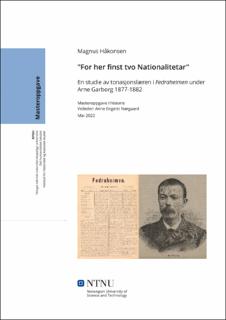| dc.description.abstract | Denne mastergradsavhandlingen undersøker hvordan tonasjonslæren, en radikal nasjonalistisk ideologi, kom til uttrykk i avisen "Fedraheimen" i perioden 1877-1882. I denne perioden var landsmålsforfatter og samfunnsdebattant Arne Garborg redaktør for avisen. Garborg hadde rett forut for avislanseringen bragt tonasjonslæren ut i offentligheten med boken Den ny-norske Sprog- og Nationalitetsbevægelse. Det sentrale punktet i læren var at Norge etter Garborgs oppfatning var delt i to nasjonaliteter; en ekte norsk nasjonalitet på den ene siden, og en unorsk eller dansk-norsk på den andre. I boken brukte Garborg først og fremst språket som skillelinje mellom nasjonalitetene, der de som snakket bygdedialekter og sympatiserte med landsmålet kunne regnes som norske. Bybefolkningen, med sitt dansknære talemål og skriftspråk, kunne ikke det.
Oppgaven benytter ulike teoretiske rammeverk for å drøfte tonasjonslærens rolle i
"Fedraheimen" gjennom Arne Garborgs redaktørperiode. Quentin Skinners teorier for hvordan man skal forstå historiske tekster, samt nasjonalismeteori er de primære arbeidsverktøyene. Nasjonalismeteoretisk legges det hovedvekt på å analysere tonasjonslæren i lys av skillet mellom etnisk og statsborgerlig nasjonalisme. Sentrale elementer gjennom hele oppgaven er å diskutere hvordan lærens teoretiske grunnlag endret seg gjennom perioden, og hvordan Garborgs underliggende intensjoner med å bruke læren i avisen bidro til disse endringene.
Avhandlingen konkluderer med at tonasjonslæren var et sentralt virkemiddel
for Garborg gjennom hele perioden, men at læren fremstår som en svært dynamisk ideologi, ettersom den gjennomgikk flere betydelige endringer fra utgangspunktet i 1877. Disse endringene var både taktisk og ideologisk motiverte. Et eksempel på en taktisk endring er at Garborg i perioden 1879-1880 i stor grad la til side språket som nasjonal skillelinje, og forfektet i stedet det politiske skillet mellom Venstre og Høyre som markører for hvem som utgjorde de to nasjonalitetene. Språkspørsmålet var nemlig ikke noe som hadde støtte i hele den brede venstrebevegelsen, og Garborg måtte derav tilpasse ordbruken for at "Fedraheimen" kunne fremstå som en mer rendyrket opposisjonsavis i den politiske kampen som til slutt førte frem til regimeskiftet i 1884. Det konkluderes også med at tonasjonslæren i hele perioden var en grunnleggende etnisk nasjonalistisk ideologi, som imidlertid fikk et gradvis økende innslag av elementer fra statsborgerlig nasjonalisme utover i perioden. | |
| dc.description.abstract | This Master´s thesis analyses how “the theory of two nations” (“tonasjonslæren”), which was a radical nationalistic ideology, was expressed in the newspaper "Fedraheimen" from 1877 until 1882. During this period, the newspaper was edited by author and social commentator Arne Garborg. Prior to the commencement of the newspaper, Garborg had introduced the theory to the public in his book Den ny-norske Sprog- og Nationalitetsbevægelse. The essential point in the theory was that the Norwegian population, according to Garborg, was split in two different nationalities: A true Norwegian nationality on one side, and a Danish-Norwegian or spurious Norwegian nationality on the other. In his book, Garborg primarily used language as the dividing line for the two nationalities. Because of their native Norwegian language, the rural and peasant population could be described as true Norwegians. However, the urban population could not. Garborg argued that they had a written and oral language that was too close to Danish, and because of this, he excluded them from the true Norwegian nationality.
Throughout the thesis, various theoretical approaches are used to discuss the role of
the theory of two nations in "Fedraheimen" during Garborgs period as editor. Quentin Skinner´s theories for understanding historical texts, and theories of nationalism are the main theoretical tools for the analysis. In the field of nationalism, the thesis will especially emphasise the distinction between ethnic and civic nationalism. Important elements throughout the analysis, are to discuss how the theoretical basis of the theory changed during the time period, and how Garborg´s underlying intentions with using the theory contributed to the changes.
The thesis concludes that the theory of two nations was a central concept for Garborg
during the entire time period. However, it stands out as a very dynamic ideology, because it changes significantly from the starting point in 1877. These changes were motivated by both tactical and ideological factors. An example of a tactical factor was that Garborg, during 1879 and 1880, stopped using language as an indicator of nationality, and instead advocated that the national division was constituted by the political divide between the Liberal Party and the Conservative Party. Garborgs views on the Norwegian language as a national indicator, was not shared by the majority of the broad liberal coalition at the time. He then had to change his arguments, to ensure that "Fedraheimen" appeared as a true supporter of the Liberal Party in the political conflicts that culminated with major changes in the direction of a parliamentary democracy in 1884. The thesis also concludes that the theory of two nations fundamentally was an ethnic nationalism. However, during the time period of interest, an increasing amount of components more commonly associated with civic nationalisms gradually were included. | |
